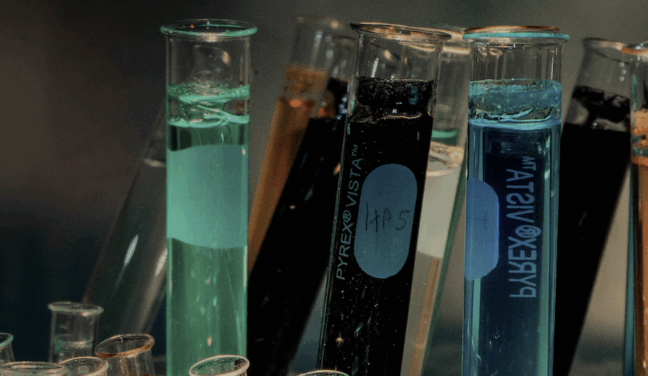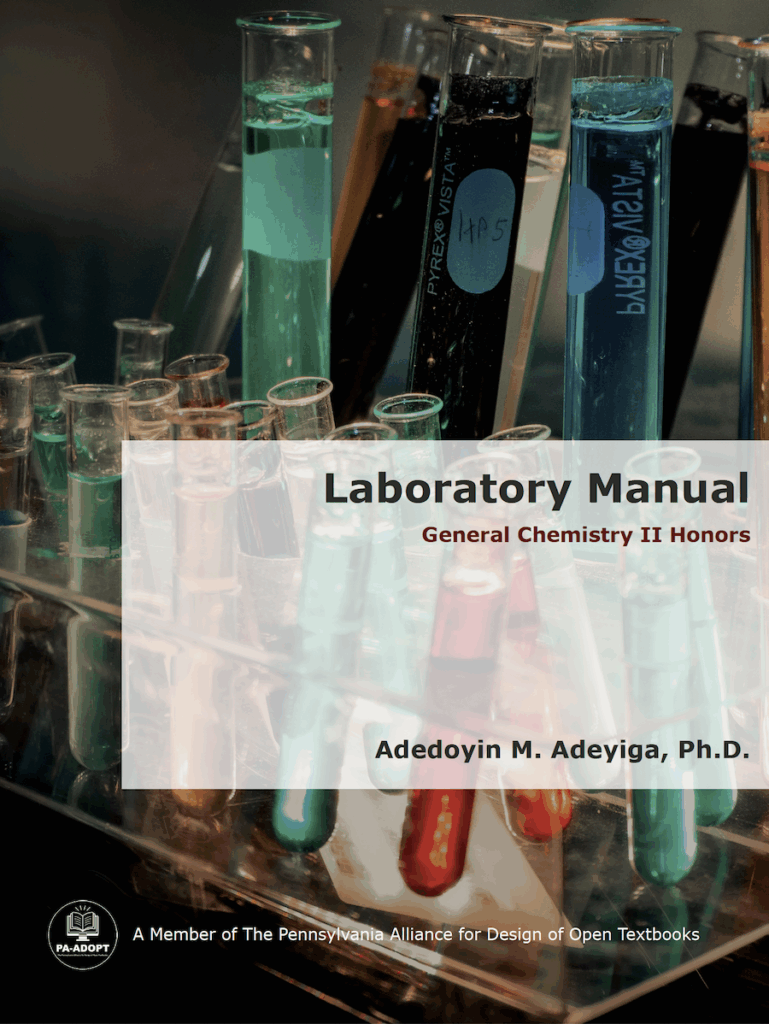
The Pennsylvania Alliance for Design of Open Textbooks (PA-ADOPT) is pleased to announce the immediate availability of our twelfth free and open eTextbook: Laboratory Manual: General Chemistry II Honors by Dr. Adedoyin M. Adeyiga, Chair of Natural and Applied Sciences & Professor of Chemistry, Department of Natural & Applied Sciences at Cheyney University.
“General Chemistry II Honors Laboratory Manual (2025) is designed to expose students to labs with applications. Chemical instrumentation for analyses of different substances is showcased; analysis of common household and environmental samples was delved into. The belief is that honors level students should get early introduction to chemical instrumentation and their use in carrying out sample testing and analysis.”
This is Dr. Adeyiga’s second eTextbook as part of the PA-ADOPT project. His first book, Laboratory Manual: General Chemistry I Honors, was released in 2023.
Please help us spread the word about our books and web site to further our work to reduce costs for students, bring equity to higher education classrooms, and give faculty the flexibility to design their own learning experiences. All of our books are available to download in both ePub and PDF formats from our Bookshelf.
Laboratory Manual: General Chemistry II Honors
by Adedoyin M. Adeyiga, Ph.D.
Keywords: Chemical Analysis, Spectroscopy, Synthesis
About the Book
General Chemistry II Honors Laboratory Manual (2025) is designed to expose students to labs with applications. Chemical instrumentation for analyses of different substances is showcased; analysis of common household and environmental samples was delved into. The belief is that honors level students should get early introduction to chemical instrumentation and their use in carrying out sample testing and analysis.
Chapters
- Preface: Calculations in the Chemistry Laboratory
- Experiment One: Chemical Spectroscopy Lab
- Experiment Two: Total Organic Carbon (TOC) Analysis of Different Bottled-Water
- Experiment Three: Total Organic Carbon (TOC) Analysis of Sugar in Carbonated and Non-Carbonated Drinks
- Experiment Four: Saponification Reaction – Making Solid and Liquid Soap
- Experiment Five: Synthesis and Analysis of Potassium Aluminum Sulfate Dodecahydrate, KAl(SO4)2.12H2O
Usage
Readers
The eTextbooks created as a part of this program are provided in two formats: ePub and PDF. Please refer to our Reader Support section for guidance on which format may be best for you and the device(s) you use.
Instructors
If you are an instructor seeking to use this eTextbook in your own course(s) please feel free to download the ePub and/or PDF file(s) for your use, but make sure to complete our eTextbook Usage Survey (this information is used for program evaluation purposes).
If you are interested in making revisions and edits to this eTextbook please note that this is possible since the book is under a Creative Commons License, which allows you to remix, reuse, revise, and redistribute the eTextbook. Please refer to the Faculty Support Page, specifically looking at Remixing. You can download Laboratory Manual: General Chemistry II Honors‘ Apple Pages File in order to use the original document to revise and remix the eTextbook for your purposes.
Citations
MLA: Adeyiga, Adedoyin. Laboratory Manual: General Chemistry II Honors. First, The Pennsylvania Alliance for Design of Open Textbooks (PA-ADOPT), 2025.
APA: Adeyiga, A. (2025). Laboratory Manual: General Chemistry II Honors. (First). The Pennsylvania Alliance for Design of Open Textbooks (PA-ADOPT).
Chicago: Adeyiga, Adedoyin. Laboratory Manual: General Chemistry II Honors. First. The Pennsylvania Alliance for Design of Open Textbooks (PA-ADOPT), 2025.
Peer Review
This eTextbook went through an Open Peer Review process. The peer review process used the Open SUNY Textbook Peer Review Guidelines, allowing peer reviewers to read the text carefully and evaluate the following:
- Educational Significance of Content including accuracy, appropriate and useful materials, valid and significant concepts, models, and skills, and key elements;
- Effectiveness as a Teaching Resource including a clear explanation of the concepts, alignment of materials to the learning process of the target audience, and alignment of the learning objectives with course goals; and
- Readability and Ease of Use including clarity and comprehensiveness, consistent writing style, readability and ease of use (logic, sequence, and flow), appropriateness for target readership level, and quality of Interactivity and multimedia learning objects.
As a part of the open peer review process, the public review conducted by Dr. Martilias Farrell is made available: Peer Review Document (PDF).


